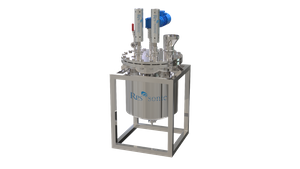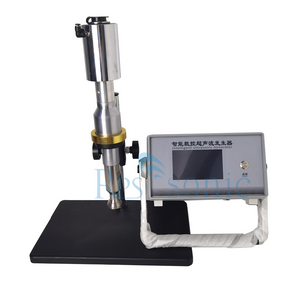Abstract The process of extracting seaweed oil by ultrasonic enhancement technology was studied. The effects of extraction solvent dosage, extraction temperature, extraction time, ultrasonic action mode, ultrasonic power and frequency on ultrasonic extraction of seaweed oil (EPA as an indicator) were discussed. The appropriate process conditions were optimized to provide a theoretical basis for industrial production and the promotion and application of ultrasonic enhancement technology.
Seaweed is a marine micro-phytoplankton with many important pharmacological functions and has broad development prospects in the fields of food and medicine. Its seaweed oil, polyunsaturated fatty acids, is not only an important component of higher animal cells, but also has special preventive and therapeutic effects on cardiovascular diseases. It has anti-atherosclerosis, lowering blood lipids, inhibiting platelet aggregation, lowering blood pressure, anti-inflammation, regulating immune function, anti-allergic reaction, anti-tumor and anti-cancer effects, among which eicosapentaenoic acid (EPA) and docosahexaenoic acid (DHA) are particularly prominent.
At present, the process of extracting seaweed oil by ultrasonic enhancement technology has received extensive attention and research. Ultrasonic wave is a sound wave with a frequency of 2×10⁴~2×10°Hz, which has thermal effect, mechanical effect and cavitation effect. Ultrasonic wave can enhance the solvent extraction process, shorten the extraction time, reduce the solvent capacity and improve the extraction rate. It is a new technology with development potential to enhance the extraction by using external force field (4). This paper studies the process of ultrasonic enhanced extraction of seaweed oil to promote the progress of seaweed oil extraction process and the development of ultrasonic enhanced technology.
1 Experimental part
1.1 Materials and instruments
Chlorella sp.: purchased from the Institute of Marine Biology, n-hexane: Shanghai Lingfeng Chemical Reagent Co., Ltd.
Ultrasonic transmitter PTS-300: Guangzhou Dongfang Ultrasonic Equipment Factory, electric constant temperature water bath H-S-G-IIB-6: Shanghai Instrument Supply and Marketing Company, rotary evaporator: Shanghai Glass Instrument Factory, vacuum drying oven DZ-80: Shanghai Nanhui Laogang Tool Factory, GC-112 gas chromatograph: Shanghai Analytical Instrument Factory. 1.2 Process Flow
The process flow of algae oil extraction is as follows:
Solvent filter residue solvent recovery
↓ ↑
Seaweed → ultrasonic extraction → filtration → concentration → drying → seaweed oil → detection of EPA content
1.3 Determination of EPA
The GC-112 gas chromatograph was used for determination. The parameters were: chromatographic column (HP-WAX, 30m×0.25m×0.25μm), column temperature of 195℃, detection temperature of 250℃, carrier of pure nitrogen, and flow rate of 37 mL/min. The EPA content was calculated by normalization method.
2 Results and discussion
2.1 Relationship between seaweed oil extraction rate and extraction temperature
When the amount of raw materials was constant, the material: liquid ratio was 1:1, and the extraction was carried out under 25 kHz, 300 W ultrasonic conditions for 20 min. The extraction temperature was changed for the experiment, and the results were shown in Figure 1. As can be seen from the figure, with the increase of extraction temperature, the seaweed oil extraction rate also increased, but when the temperature was higher than 50℃, the extraction rate basically did not increase.
2.2 Relationship between seaweed oil extraction rate and solvent dosage (material-liquid ratio)
Under (50℃) and 25 kHz, 300W ultrasonic conditions, the solvent dosage (material: liquid) was changed for experiments, and the results are shown in Figure 2. Curve 1 is under ultrasonic action; Curve 2 is without ultrasonic action. It can be seen from the figure that the use of ultrasonic enhanced extraction can significantly improve the utilization rate of the solvent, thereby reducing the amount of solvent; the seaweed oil extraction rate increases with the increase of solvent dosage. When the solvent dosage reaches 3 times the amount of raw materials (material: liquid = 1:3), the extraction rate increases slowly, and increasing the amount of solvent n-hexane has no obvious significance.
2.3 Relationship between seaweed oil extraction rate and extraction time
Under (50℃) and 25 kHz, 300 W, different extraction times were used for experiments, and the results are shown in Figure 3. Curve 1 is under ultrasonic action; Curve 2 is without ultrasonic action. The extraction rate under ultrasonic action is higher than that without ultrasonic action, and the extraction time is significantly shortened. When the time is increased to 40 min, the extraction rate increases slowly.
2.4 Effect of ultrasonic action mode on seaweed oil extraction rate
When other conditions are constant (50℃, material: liquid = 1:3, 20 min, 25 kHz300 W), the ultrasonic action mode is changed: continuous action, first stop and then action, first action and then stop, pulse action, and the experiment is carried out. The results are shown in Figure 4. As can be seen from the figure, continuous action is the most suitable.
2.5 Effect of ultrasonic power and frequency on seaweed oil extraction rate
When other conditions are constant (50℃, material: liquid = 1:3, 20 min, continuous ultrasonic action), the ultrasonic conditions are changed: 25 kHz 300 W, 40 kHz 100 W, 40 kHz50W, 19 kHz50W, and the experiment is carried out. The results are shown in Figure 5. As can be seen from the figure, 25 kHz300W is the most suitable.
3 Conclusion
3.1 The experiment shows that when using n-hexane to enhance the ultrasonic extraction of seaweed oil, the amount of extraction solvent and the extraction temperature have a significant effect on the yield of seaweed oil extract. According to the experimental results, the solvent dosage is 1:3 (material: liquid) and the temperature is 50℃. The extraction time is preferably 40min.
3.2 The ultrasonic action mode, ultrasonic power and frequency have a significant effect on the extraction rate of seaweed oil. According to the experimental results, continuous action, 25 kHz 300 W are appropriate.
3.3 Experimental comparison shows that the use of ultrasound to enhance the solvent extraction process can shorten the extraction time, improve the solvent utilization rate, reduce the amount of solvent, and improve the extraction rate. Ultrasound is a new technology with development potential that uses external force to enhance extraction, and it is recommended to promote its application.
 English
English












